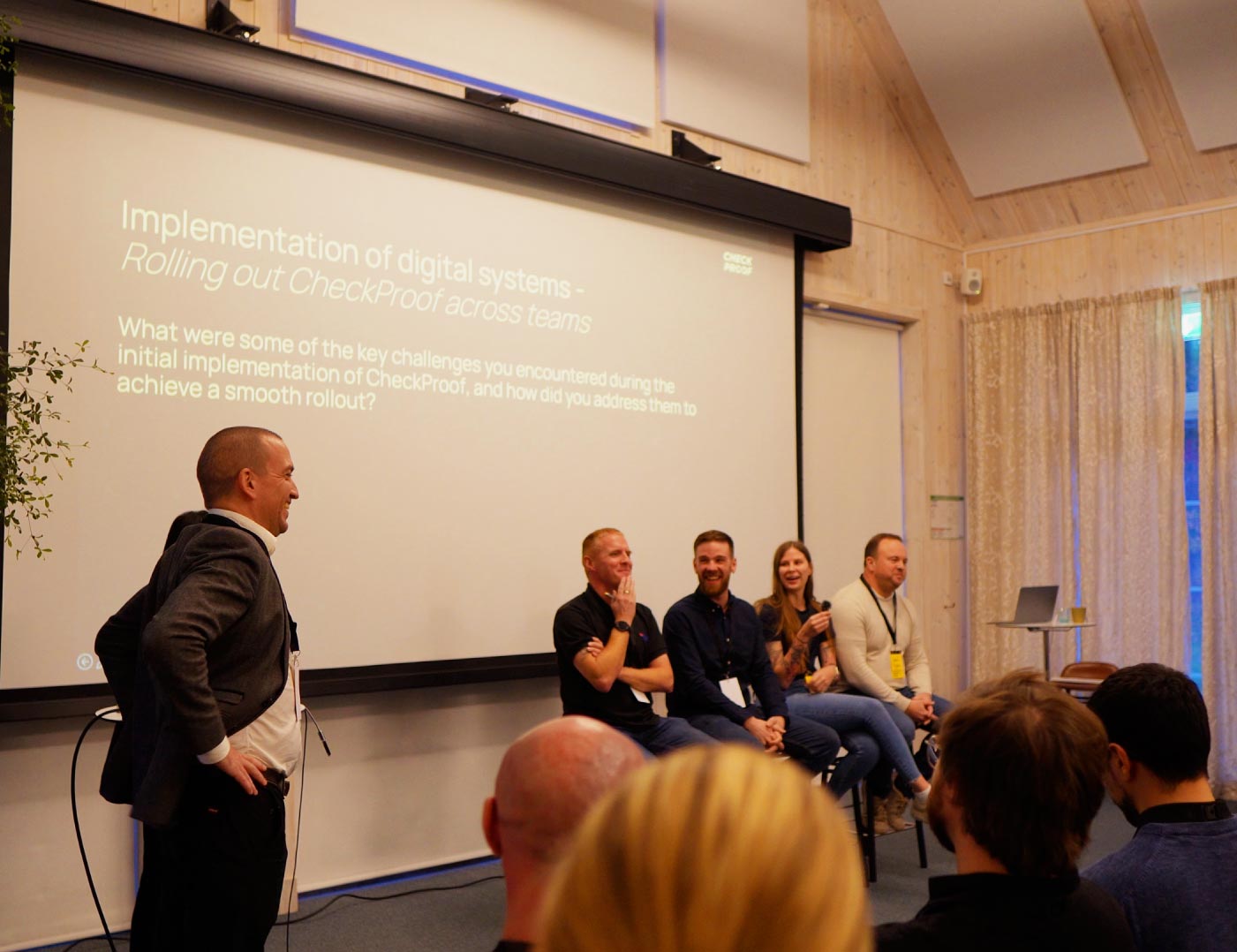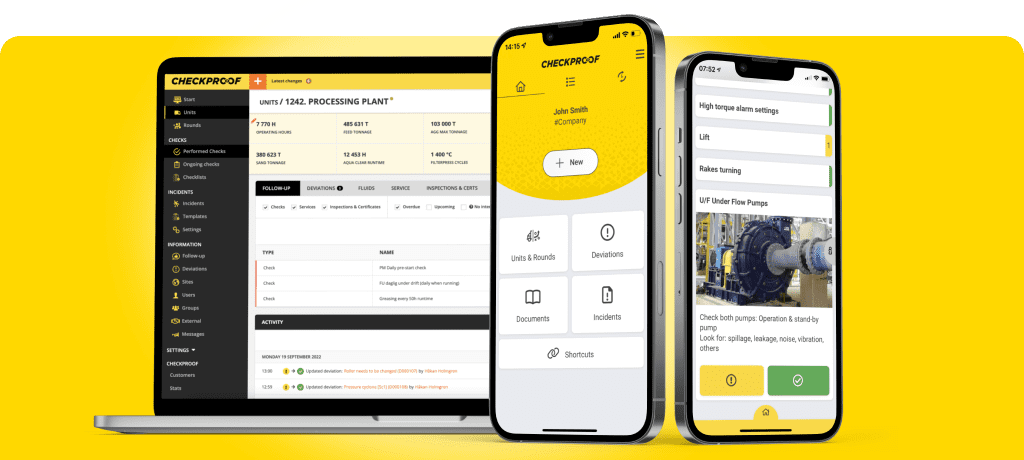Staff resistant to change? It’s a familiar story: “I don’t need this,” or, “We’ve always done it this way. If it’s not broken, why fix it?” Resistance to new systems can be a major challenge. Still, as highlighted during a recent client panel, the rollout of CheckProof has proven transformative. Representatives from Cemex Germany, Breedon Group, Banner Contracts, and Peab Industry participated in the panel conversation. We asked them four questions regarding their implementation of CheckProof’s platform and app. The learnings can be applied when planning a rollout of any new system across a business.
CheckProof’s clients discuss learnings from implementing CheckProof’s platform across different teams and sites in a panel conversation.
Meet the Panelists
Brett Burrows, Banner Contracts
HSEQ and Compliance Manager for contract crushing operations in Northern England and has implemented CheckProof at Banner Contracts over the past two years. Previously worked at Cemex UK and Breedon Group.
Andrew Hogg, Breedon Group
Maintenance Manager at Breedon Group. Played a key role in implementing CheckProof at Breedon Group.
Gina Becker, Cemex Germany
Responsible for digitization and process optimization, at Cemex Germany, focusing on concrete, cement, and aggregate supply.
Niklas Engblom, Peab Industry
Manages mobile machinery for Peab Industry across the Nordic countries, including concrete trucks, paving machines, rollers, and excavators.
What were some of the key challenges you encountered during the initial implementation of CheckProof, and how did you address them to achieve a smooth rollout?
Rolling out CheckProof required addressing both technical and cultural hurdles.
- Brett Burrows, Banner Contracts: People assume the old quarry guys won’t get it, but they usually see the benefits early on. It’s the management who need to act on the data coming in to show ground-level users the impact of their input. To overcome this, you need to invest time into it.
- Andrew Hogg, Breedon Group: The system’s versatility can sometimes mean key people who adopt it first want to run away with it and do so much more. Early adopters often want to implement too much too soon. We had to focus on nailing the key items first, setting the framework, then gradually expanding and adding all the extras.
- Gina Becker, Cemex Germany: We underestimated the resources needed for implementation. Time and training are essential to guide teams through the transition. Perhaps through seminars and truly teaching people how it’s done.
- Niklas Engblom, Peab Industry: Patience is key. Step-by-step implementation and emphasizing benefits are critical, especially for those less inclined toward digital tools. In the past, we’ve done things on paper, those records are easily lost, so people tend to see the benefit of having a system where it’s all recorded.
“We had to focus on nailing the key items first, setting the framework.” Andrew Hogg, Breedon Group
How did you ensure that teams on the ground embrace the CheckProof system and what strategies have been effective for driving user adoption?
Building enthusiasm among team members and finding natural points for frequent engagement with the system is pivotal to a successful rollout.
- Gina: People often resist because of past bad experiences with other systems. Positive reinforcement and showing them how it simplifies their work—reducing paperwork and improving efficiency—helped change their mindset. They want someone to take them by the hand and guide them. I would often hear, I’m here to mix concrete, why am I now IT support? However, showing that they’re not doing anything they’ve not done before, but simply in a new format was helpful. And when they see the reduction in time and paperwork – this helps. So positive reinforcement, patience and empathy.
- Andrew: Ground-level adoption was smooth. The challenge was ensuring management acted on the influx of data to maintain a positive feedback loop. So the focus was to also support the management team to act on all the information coming from the field. We had the situation that once a few people got it even more people wanted it. We didn’t have a problem with adoption, it was more about keeping up with the rollout.
- Brett: Yes, you suddenly realize once you start reporting deviations effectively, you get an influx of hundreds of deviations, so closing them out and getting them fixed required hard work. But to drive adoption, we encouraged users to engage with the platform frequently, such as adding additional daily checks. So, we added a second check, an environmental check. The more familiar they became, the more proficient they were. Then, users can show others and find new ways of using the system without much training as they’re used to it.
- Niklas: We also had resistance initially, but we needed to keep at it. Site managers played a crucial role in explaining the value to their teams and following up consistently. Internal communication played w big part, so that everyone in the whole chain understood the value.
“People often resist because of past bad experiences with other systems.” Gina Becker, Cemex Germany
Can you share any measurable improvements or unexpected benefits that emerged from using CheckProof in your operations?
Panelists shared measurable improvements and unexpected benefits from using CheckProof:
- Niklas: The ability to collect all the information in one place was helpful to us. We have saved time and money by using photos and videos to understand machine issues remotely. Before, if a problem was reported, you’d have to send a service van to the field, to check before ordering the parts. It’s reduced unnecessary trips by service teams and improved workshop efficiency. In the workshop we have 220 machines and 1000 notices on paper, but now that it’s all collected on the platform, you don’t miss anything.
- Gina: Our plant managers started using the system in ways we hadn’t anticipated, like turning deviations into a ‘ticket system’ for maintenance. So, the deviation system replaced repair orders and in turn, increased the efficiency of the maintenance team as they were able to complete more checks and repairs in less time. That was an unexpected benefit.
- Andrew: A big win from the maintenance side of things was that infrequent maintenance checks became much easier to track, leading to better outcomes for high-level maintenance tasks. It truly helped with tasks that had more obscure maintenance schedules, so no annual checks were missed.
- Brett: We’ve truly pushed the boundaries of what you can do with CheckProof’s system. At Banner, we integrated health and safety training, timesheets, and PPE requests into the system. It’s made audits significantly easier and earned positive feedback from auditors. We’ve done quite a few ISO audits now, where all the data has come from CheckProof. I can also get production reports each night from various sies, so if a particular site has had many deviations and a less optimal production day, you can piece that information together.
Looking back is there anything you would do differently in your rollout process, or any advice you’d give to companies starting their own implementation?
- Brett: You need to keep improving your approach—don’t be afraid to make changes. Start by getting the naming conventions and systems for your rounds right from the beginning. Take it site by site because every site and user is different; no two sites are the same.
- Andrew: The way people use the tool can vary, so it’s important to have a framework in place. If the system is brand new to you, spend enough time testing before committing to a full rollout. This minimizes the need for changes later, which can affect adoption. Play around with the system, develop your framework, and then begin testing and rolling it out. Also, speak with CheckProof staff—they can provide helpful ideas. For sites without advanced maintenance solutions like thermal imaging, CheckProof is a game-changer. It makes identifying defects easier and speeds up the overall process.
- Gina: Start with a clear plan and designate someone to champion the implementation. Roll it out at one plant first, and if done well, it will motivate other plants and teams to adopt it. Focus on the sites that are likely to succeed, as they can inspire others. At the same time, be prepared to offer extra support to sites or teams that may be more resistant or face challenges.
- Niklas: Begin with teams that are ready and willing to adopt the system. Take it step by step—don’t overwhelm users by filling up checklists immediately. Share information clearly from management to the team on the ground because any gaps in communication will slow down the process. With CheckProof, teams are logging more details. In the past, they might not have reported an issue, but now everything is tracked. When service technicians arrive, they bring all the necessary parts, which keeps our machines in better shape. By gathering detailed information, we can replace parts before they fail, reducing downtime and avoiding breakdowns.
“To drive adoption, we encouraged users to engage with the platform frequently, such as adding additional daily checks.” Brett Burrows, Banner Contracts
Key takeaways
- Start small: Focus on one site or key team first. Success in one area can motivate others.
- Plan thoroughly: Create a clear framework before rollout to minimize mid-implementation changes.
- Support both management and teams on the ground: Ensure management is equipped to act on data quickly to maintain motivation on the ground.
- Be patient and adaptive: Tailor the implementation to each site’s needs and refine processes as you go.
Digital transformation isn’t without its challenges, but as these industry leaders demonstrated, the right tools and strategies can turn resistance into adoption and deliver measurable results. Whether it’s saving time, reducing costs, or making processes more effective, CheckProof has proven itself as a versatile and impactful solution for optimizing operations across teams.
If you’re ready to take the first step toward transforming your processes, start small, plan well, and watch the benefits unfold.
Want to know what CheckProof can do for you?
CheckProof's easy-to-use app makes it easier to do the right thing at the right time. Discover how you can run world-class maintenance that is both cost-effective and sustainable.

Revolutionizing Compliance: Banner Contracts on managing ISO audits with CheckProof

Implementation of Digital Systems: Rolling Out CheckProof Across Teams

From Fuel Savings to Production Gains: Cemex Germany’s Wins with CheckProof

A Recap of the CheckProof Industry Event & 10th Anniversary Celebration

Trend Report: Key moments in the Construction Materials industry (2014–2024)

Meet Marcus Edlund, CheckProof’s First Employee and Tech Trailblazer

10 Key Technology Advancements in the Construction Materials Industries

SBMI’s Climate Roadmap for a Fossil-Free Aggregate Industry by 2045

HSEQ trends in the Construction Materials and Heavy Industry






